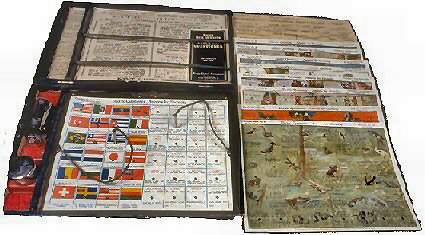 The Museum purchased this game in 1982. Actually, The Electric Questioner is not an "electronic" game per se - but rather is a forerunner - an "electric" game. It was made by the Knapp Electric Corporation, Port Chester, New York, USA, between 1928 and 1930. The game's creator, David W. Knapp, was an inventor who marketed battery operated games. It was made during a period of time in which the public was fascinated with the concepts of electricity and communications.
The Museum purchased this game in 1982. Actually, The Electric Questioner is not an "electronic" game per se - but rather is a forerunner - an "electric" game. It was made by the Knapp Electric Corporation, Port Chester, New York, USA, between 1928 and 1930. The game's creator, David W. Knapp, was an inventor who marketed battery operated games. It was made during a period of time in which the public was fascinated with the concepts of electricity and communications.
The box lid features a picture of the then communication towers at night. The lid is hinged to the box bottom, and the inside of the lid not only features information about the game and the battery, but also includes the Morse and Continental Telegraph Codes.
The bottom of the box is 24.1cm long x 35cm wide x 5.5cm high and is divided into two compartments. On the lower left side is a battery storage cylinder and metal contacts, and a metal buzzer on a red metal base. On the larger right side of the box bottom are 48 metal projections (attached by a hidden network of wires) over which the question boards fit. Attached to the top of the box bottom are two extended insulated wires with metal tips that radiate from a metal clamp. The clamp can function as a telegraph key. The extended wires are to be used in playing the game.
 15 different game boards (9 in color) 20.9cm long x 26.6cm wide are included in the box.
The boards vary in topic and type of content. For example: Robinson Crusoe, Evangeline, Famous Ships of American History, Alice in Wonderland, Life of George Washington, Elementary Chemistry, Biblical Facts, China, Baron Munchausen, and more. Some boards include pictures and text, others only text. All boards have 48 holes, with one hole at each text question or picture. The boards fit over the 48 metal projections in the box bottom. A player takes one of the insulated wires and touches the metal tip to the metal projection next to a text question or picture. The tip of the second wire is then touched to the metal projection elsewhere on the board which the player thinks is the answer to the question. If the player is correct (and the battery is active), a buzzer sounds (as a result of a completed electric
circuit). If the player is incorrect there is no sound (no completed circuit), and the player can move the second wire to another metal projection and guess again.
15 different game boards (9 in color) 20.9cm long x 26.6cm wide are included in the box.
The boards vary in topic and type of content. For example: Robinson Crusoe, Evangeline, Famous Ships of American History, Alice in Wonderland, Life of George Washington, Elementary Chemistry, Biblical Facts, China, Baron Munchausen, and more. Some boards include pictures and text, others only text. All boards have 48 holes, with one hole at each text question or picture. The boards fit over the 48 metal projections in the box bottom. A player takes one of the insulated wires and touches the metal tip to the metal projection next to a text question or picture. The tip of the second wire is then touched to the metal projection elsewhere on the board which the player thinks is the answer to the question. If the player is correct (and the battery is active), a buzzer sounds (as a result of a completed electric
circuit). If the player is incorrect there is no sound (no completed circuit), and the player can move the second wire to another metal projection and guess again.
Last update March 17, 2010